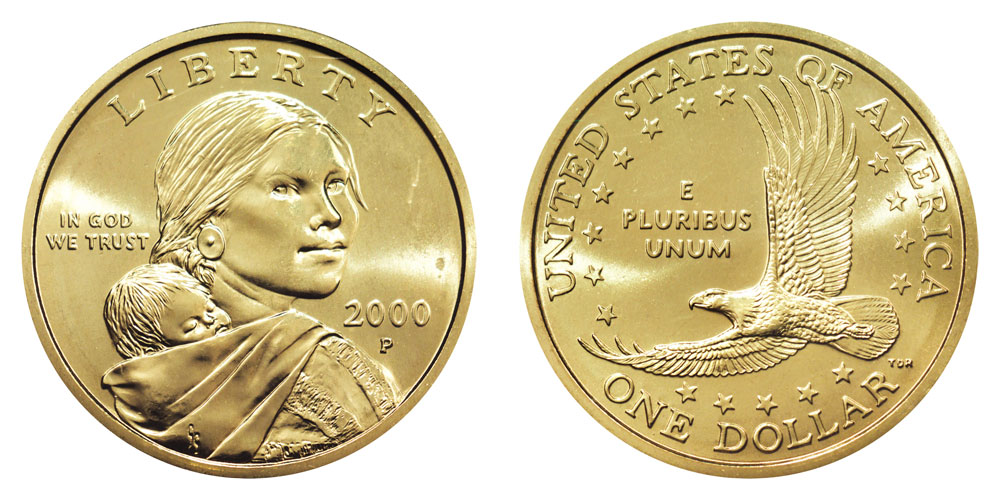Remember the excitement over the Sacagawea coin? If you were in any way involved with the coin collecting community in 2000, you may recall the buzz surrounding the long-anticipated release of the Sacagawea dollar coin. The Sacagawea golden dollar was supposed to fix all of the problems associated with the Susan B. Anthony dollar, which had been released in 1979 but quickly failed to circulate. By 1981, the coin was in production only for coin sets. Later that year, the SBA dollar was retired. It was minted again one last time in 1999, when dollar coins were seeing circulation in the postage stamp machine circuit and some mass transit systems.
The rise use of the dollar coin in the late 1990s brought many in the numismatic community to believe that Sacagawea dollar coin would be a success. Yet, despite efforts and a massive public outreach campaign by the United States Mint encouraging the use of the new dollar coins, the Sacagawea coin failed to gain acceptance. One thing is for sure – the failure of the Sacagawea coin to widely circulate wasn’t due to confusion of the coin with the quarter-dollar, which was part of the downfall for the Susan B. Anthony dollar in the early 1980s.
Designing the Sacagawea Coin
Sacagawea Dollar Wounded Eagle
Glenna Goodacre designed the obverse design for the Sacagawea dollar coin. Featuring a portrait of Shoshone woman Sacagawea, who accompanied Lewis and Clark on their 1804-06 expedition throughout what would become the western United States, the dollar became the first circulating U.S. coin to feature the figure of a Native American in decades; the Buffalo nickel, which features an obverse depiction of a Native American, was struck from 1913 through 1938.
As Goodacre didn’t have any contemporary portraiture of Sacagawea to use in creating the design, she asked a 22-year-old Shoshone woman named Randy’L He-Dow Teton to pose as a model for the coin. Goodacre also included an image of Jean Baptiste Charbonneau, Sacagawea’s newborn son, on the dollar coin design.
The Date and Mint Mark were moved to the edge of the Sacagawea Dollar with the release of the Native American coin Series in 2009 which retained the Sacagawea Bust on the Obverse. I do not have an image of a 2009 coin but offer this image of the 2010 version from the US Mint. Pictures, even rudimentary pictures would answer a lot of questions. Sacagawea Silver Dollars APMEX offers a superb selection of Sacagawea Dollars. Released in 2000 to honor the Shoshone Indian guide who aided Lewis and Clark’s expedition west in 1804, Sacagawea Dollars were created to replace the Susan B. Anthony dollar coin, which had significantly dwindled in supply since its release in 1979.

Sacagawea Dollar Value
Additionally, the Sacagawea dollar coin features a distinctive golden color. Many people outside of the coin collecting community originally thought Sacagawea dollar coins actual gold. Of course, that couldn’t be the case given the high bullion value of gold.
What Makes the Sacagawea Golden Dollar “Golden”?
The coin’s metallic composition includes a pure copper core with an outer layer consisting of manganese brass (77% copper, 12% zinc, 7% manganese, and 4% nickel).
The Sacagawea dollar coin weighs 8.1 grams, which makes it heavier than any coin that was widely circulating in 2000, when the series was released; it should be noted that copper-nickel half dollars weigh 11.34 grams, but half dollars were not widely circulating in 2000, making the quarter the next-heaviest circulating denomination at the time, at 5.67 grams.
What Happened to the Sacagawea Dollar Coin?
Nowadays, the Sacagawea golden dollar coin, like the half dollar, fails to circulate. In fact, Sacagawea dollars haven’t been struck for circulation since 2001. Doubtlessly, the reason dollar coins don’t circulate well these days is because they don’t have to – the dollar bill siphons away any logistical need for using a dollar coin. It’s widely theorized that if the dollar coin was put into production and the dollar bill was pulled from commerce, people would widely use the dollar coin through force. A similar scenario happened in Canada during the late 1980s, when that nation transitioned away from using dollar bills and replaced them with small-size, gold-colored “Loonie” dollar coins.
In 2009, the reverse of the Sacagawea dollar coin has been used to display special, annually changing designs depicting key figures and moments in Native American history. These designs will be used for the duration of the Presidential dollar coins, which were first struck in 2007 and are slated to end in 2016.
Sacagawea Coin Values
Standard uncirculated Sacagawea dollar coins are worth $2 to $3, with proofs selling for $10 to $15. The 2000 Goodacre presentation finish Sacagawea coins were struck in a very small quantity (5,000 pieces) and are worth around $600 each.
The 2001-S and 2002-S proof Sacagawea dollar coins are worth $50 and $25 respectively.
Related Posts
US Mint Opens 2018 World War I Silver Dollar Design Competition
Ronald & Nancy Reagan to be Featured on Coins in 2016
United States Mint To Release Pink Gold, Other Breast Cancer Commemorative Coins in 2018
By accepting you will be accessing a service provided by a third-party external to https://coinvalues.com/